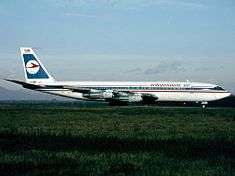Independent Air Flight 1851
 An Independent Air Boeing 707 sister ship of the accident aircraft | |
| Accident summary | |
|---|---|
| Date | 8 February 1989 |
| Summary | Controlled flight into terrain, pilot error |
| Site |
Pico Alto, Santa Maria Island, Azores 36°58′53″N 25°05′28″W / 36.981475°N 25.091008°WCoordinates: 36°58′53″N 25°05′28″W / 36.981475°N 25.091008°W |
| Passengers | 137 |
| Crew | 7 |
| Fatalities | 144 (all) |
| Survivors | 0 |
| Aircraft type | Boeing 707-331B |
| Operator | Independent Air |
| Registration | N7231T[1] |
| Flight origin | Orio al Serio Airport, Bergamo, Italy |
| Stopover |
Santa Maria Airport, Santa Maria, Azores |
| Destination |
Punta Cana, Dominican Republic |
On 8 February 1989, Independent Air Flight 1851, a Boeing 707 on an American charter flight from Bergamo, Italy to Punta Cana, Dominican Republic, struck Pico Alto while on approach to Santa Maria Airport in the Azores for a scheduled stopover. The aircraft was destroyed, with the loss of all 144 on board, resulting in the deadliest plane crash in Portugal's history.
Accident
During final approach to Santa Maria Airport, the air traffic controller instructed the crew to descend to 3,000 feet (910 m) for an ILS approach to runway 19. During that transmission, a trainee controller had also transmitted an incorrect QNH (barometric altimeter setting) that was 9 hPa too high. The approach instructions were not fully heard since the pilot had re-keyed his microphone to acknowledge the new QNH, and likely did not hear the second repeat of the 3,000 ft safe altitude, declaring: "We’re re-cleared to 2,000 feet..." (610 m). Although the first officer questioned the barometric altitude, the captain agreed that the first officer had heard the read-back correctly.
After having been cleared to the ILS approach, the crew failed to accomplish the approach briefing, missing an opportunity to notice the 3,000 ft minimum safe altitude and the presence of Pico Alto.
Leveling off at 2,000 feet (610 m), the airliner experienced heavy turbulence near Santo Espírito and subsequently impacted the ridge of Pico Alto in a level attitude at an altitude of 1,795 feet (547 m). There was no evidence of any in-flight emergency and the altimeter was found correctly set to 1027 mb.
Report
The Board of Inquiry determined the accident was due to non-observance by the crew of established operating procedures which led to the deliberate descent of the aircraft to 2000 feet when the published minimum sector altitude was 3000 feet. It also found that the controller had put the aircraft 240 feet (73 m) below that indicated on board the aircraft, exacerbating the original error by the first officer.
Other factors:
- Bad communications techniques on the part of the co-pilot and controller, including the non-adherence to standard phraseology in some of the ground communication.
- Neglecting aerodrome control tower procedures in not requesting a readback of the descent clearance.
- The limited international flying experience of the crew and the airline's deficient crew training that did not include emergency maneuvering techniques for terrain avoidance.
- Non-compliance with the National Institute of Civil Aviation of Portugal Aeronautical Information Publications (flight plan procedures and authorized routes).
Lawsuit
In 1992, a group of next-of-kins, claimed Independent Air and the lessor of the aircraft, International Air Leases, were responsible for the loss of their relatives and wanted to be compensated. In the court cases that followed, Independent Air was judged to be negligent based on the following statement: "undisputed facts show that the pilot and crew flew the plane below an altitude of 3,000 feet, when their charts of the area clearly showed that it was dangerous to go below 3,000 feet because of the mountain. The pilot in command cannot excuse his act by alleging the air traffic controller directed him to descend to an altitude of 2,000 feet and gave him an incorrect altimeter setting. In descending below the safe indicated altitude, he knowingly placed the plane in a dangerous situation. He then proceeded to fly into the top of the mountain that he knew was there".[2] The case was settled for $34,000,000.[3]
References
- ↑ "FAA Registry". Federal Aviation Administration.
- ↑ "Independent Air vs Tosini".
- ↑ "Spenser & Krause - Our Work and Past cases".
- Duke, Thomas A. (February 1995), "Aircraft Descended Below Minimum Sector Altitude and Crew Failed to Respond to GPWS as Chartered Boeing 707 Flew into Mountain in the Azores" (PDF), Accident Prevention, Flight Safety Foundation, 52 (2): 1–15 (Archive)
- UK CAA (April 1976), CAA Document 429: World Airline Accident Summary, ICAO
External links
- Accident description at the Aviation Safety Network
- Photos of N7231T at Airliners.net
- Independent Air Boeing 707 CVR Readout